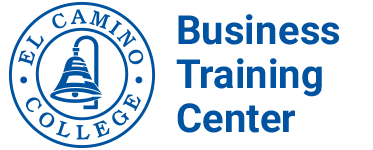
Excel spreadsheet expert Alva Santiago
Alva Santiago is an Excel spreadsheet wizard who works with clients and teaches students who “want magic to happen with their data.” That magic typically occurs when she guides a user through a project and arrives at the outcome they had hoped for. She is the model instructor/practitioner for which so many community colleges are renowned. She brings the same business approach to the classroom that she brings to the work she does with her consulting clients. The reward she prizes most from her dedication to teaching is hearing the sound of excitement from her students when they validate their understanding of a new, more efficient process, of a new way to visualize the data they are working with. That is what she strives for each time she steps into a classroom. The Center for Customized Training is pleased to present the following interview with Alva Santiago.
Q: How long have you been an instructor for the Center for Customized Training at El Camino College?
Alva Santiago: I’ve been working with Eldon Davidson, director of the Center for Customized Training, for about 10 years. I have been working as a trainer since 1992 and have had my own business, Workforce Computer Training, LLC, for more than 20 years.
Q: What is your corporate or business world training experience?
Santiago: I’ve worked with many aerospace companies, including SpaceX, HydroFLOW, Honeywell, Lisi Aerospace, GKN Aerospace and Impresa Aerospace. In college, I completed my undergraduate studies in accounting. Before moving to California to start my consulting practice, I worked on Wall Street for 10 years.
In my role as a consultant, I meet with clients and find out what their needs are. What I gather from those assessments, what I learn during those interactions, I incorporate into my training classes. That is the process by which I formulate my curriculum. My goal for my incumbent worker students is to present information and exercises that will connect them to the real world, to the work they are asked to perform in the workplace.

Typical Excel spreadsheet
Q: You have a Microsoft training certification?
Santiago: Yes. I took courses sponsored by Microsoft and became certified in Microsoft Office. I then elevated my certification to master trainer, which is a term they don’t use anymore. I took the 2019 version of the certification program and am now designated as an “expert.”
I also bring extensive coding experience into the classroom, which I draw upon to show students how to build things like automated macros. It’s extremely helpful to be able to tweak the code in a Excel spreadsheet to make it work in your favor. I let my students know that they shouldn’t take the Excel program at face value. I show them that by playing with the code, they can streamline work that took five steps and do it in two or three steps. This is an aspect of the training that students find valuable.
Q: Do your students bring their real-world projects to the classroom for discussion?
Santiago: Yes. My students come into class with lots of data, and they want to know, “OK, so how do I work with this? I need to create reports for my boss.” The first question I ask them is, “Do you trust your data? Are you sure the data you’re working with is clean? Is the information that you are going to report real?” I want to make sure they know how to analyze the data so that the output will be exactly what they expect it to be. That’s the approach I take. I tell my students to bring their own spreadsheets—as long as the data is not private. We work on those spreadsheets so when they complete the class, they have an excellent takeaway to bring back to the workplace. I try to provide a collaborative classroom experience for my students.
Q: Do you teach the entire Microsoft Office suite?
Santiago: Yes. The classes I teach are separated by application. If I’m teaching Excel, we’ll introduce three different levels for the participants. I will ask them if they want to start with the beginning, intermediate, advanced, or start at the beginning and cover all three levels. I do the same for Word, PowerPoint, Outlook, Visio and Microsoft Project classes.
Q: You’ve mentioned that your goal is to give your students a deeper understanding of data. How do you go about doing that?
Santiago: What I do is I give them ideas about what’s important in data, which prompts them to ask questions. For example, they will ask, “How do I know my data is not clean? How do I identify certain items? I have 100,000 rows of records. How do I distinguish this data from the other data?”
I give them some guidelines of what to look for and how to get started. Initially, they can feel a bit lost. As we start to discuss all of the possibilities that are going on with the data—things they are not seeing or not aware of, many questions arise. This is how we get into the thick of things. This is where the learning starts to happen. And they start to realize that some of the past quarter reports they’ve produced may have not been super-accurate.
At this point we take a step back and I ask, “What is it you’re doing? What are your tasks? How are you handling all of that data?” Their answers to these questions are quite revealing. They tell me that they spend hours formatting the columns and getting it in the order they want; they spend a lot of time just unmerging some of the cells.
I also have many students who are high-end users. They often bring data to class from a different system. When it is put into an Excel spreadsheet, it has to be massaged. And then, it doesn’t look exactly the way they want it to look.
Going through this process we end up seeing where there are inefficiencies in the workplace because two or three people may be working on the same project. I can show them how those labor hours can be cut in half if we know how to work with the data properly.
Going through this process we end up seeing where there are inefficiencies in the workplace because two or three people may be working on the same project. I can show them how those labor hours can be cut in half if we know how to work with the data properly. That’s a big value my students can take back to their jobs, to their companies. But most importantly, I hope that my students will transform their thinking pattern and learn to visualize the outcome they want. I push them to go beyond their normal process of doing things; the repetitive actions, the trap of holding on to a handful of functions that keep them in their comfort zone.
Q: It must be exciting to see when the light goes on and the students realize, “Oh, I could be improving my reports. I could be showing something of value to my company that I wasn’t even thinking about.”
Santiago: Yes. It is what makes teaching rewarding. It is empowering for my students when I can show them how to quickly take all those numbers and say, “That represents the percentage of the total revenue you’ve received.” This can be accomplished by just dragging a column over. Then I say, “Now look at this. You can determine which month the company made the most revenue, or which product did.” With good data, they can look at the whole of the revenue, which is the product to focus on. And then we talk about the key performance indicators which gives them a focus on what’s important when they are putting data together. That opens a whole new batch of realizations, such as, “I should have been doing this all along,” or, “I should have been more focused on reporting that.” They also learn to bring more visualization into their reporting—graphics and charts that make the data more alive, easier to digest. This enables consumers of the reports to easily see how the company has been performing this quarter versus last quarter or versus this quarter last year.

Q: Do you teach Power Business Intelligence, or Power BI, in your Excel spreadsheet classes?
Santiago: Yes. That’s a relatively new component which Microsoft has integrated into the Excel spreadsheet software. Previously, Excel would allow you to have something like 1.4 million rows of data. But what happens if you have more than that? Power BI is most applicable for large international companies that need to compile data from many countries into one place. What Power BI does is create a layer that you put in front of Excel, which allows you to bring in much more data. With Power BI, you can bring up to 300 million records in one location—an amount that you never thought feasible. Yet you’re still working with Excel spreadsheet tools when you are massaging that enormous amount of data. It’s a fabulous way of being able to work with massive data. That’s what the class is about. Power BI also offers additional sophisticated tools. For example, there is a tool with which I can write what is called DAX, or Data Analysis Expressions. I can use that to massage massive amounts of data in ways that were never thought possible. Power BI is meant for super-high-level users. I am teaching a Power BI class in June through the Center for Customized Training at El Camino College.
“The Power BI class facilitates large data sets from multiple file types to come into one visual—enabling the user to get results with a simple drag and drop. This indispensable course will equip participants with the proper tools to create multiple data analysis reports with useful illustrations. Participants will be able to create measures to get key performance indexes of their organization’s products and services. They will be able to create matrixes to compare data in time segments, as in month over month and year over year.” —Course Description, Center for Customized Training
Q: It sounds like you empower your students to have an impact on their companies by using data more effectively and efficiently. Is that correct to say?
Santiago: Yes. My goal is to have them feel empowered so that when they return to the workplace, they feel they have more value to offer their employer, and they feel more engaged at work. I try to provide my students with whatever is needed for them to feel that way. That’s the place I hope to lead them to. That happens when we are communicating more like colleagues than instructor/student. That happens when we are collaborating in class. I don’t want them to think I’m this expert Excel spreadsheet guru. It’s not like that. I’m an advanced student because I keep learning and I’m not going to stop, and this is a lifetime commitment.
Often, I get a cheer from the students at the end of the class, or a standing ovation, which thrills me because I take that as a sign that I did my job well. For me, it’s like getting an Oscar.
——–
About the Center for Customized Training
We deliver customized employee training and education programs that enhance worker productivity and close the skills gaps that can constrain organizational growth. Because we work in collaboration with other community colleges, we have access to the world’s largest body of workplace-specific curriculum; this enables us to deliver virtually any training solution required by business. We have extensive experience serving industries including aerospace, logistics, technology, transportation and a wide variety of industrial manufacturers.
For more information, please contact:
Eldon R. Davidson
Director, Center for Customized Training
El Camino College
13430 Hawthorne Blvd.
Hawthorne, CA 90250
Phone: (310) 225-8258
Mobile: (562) 665-7832
edavidson@elcamino.edu

